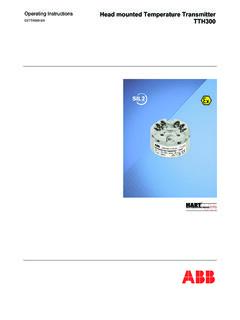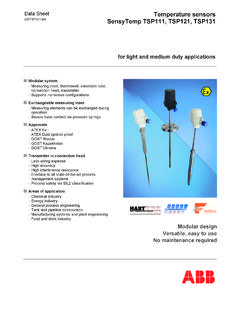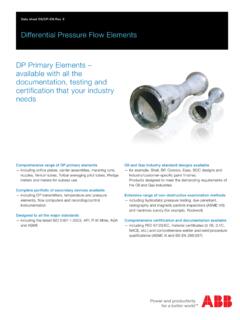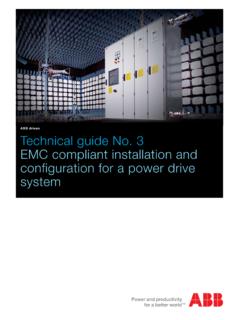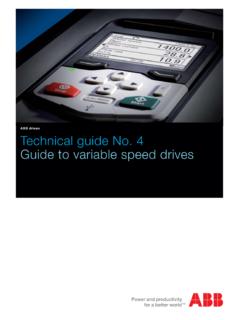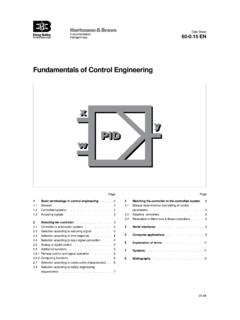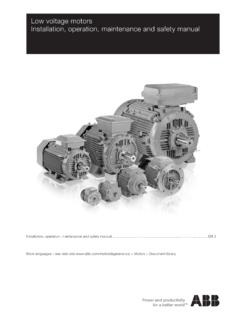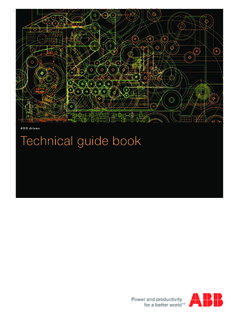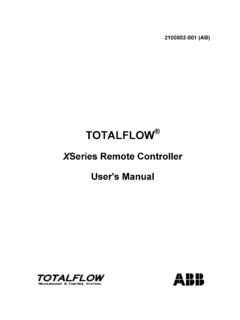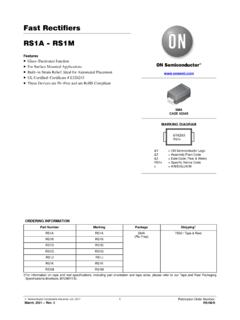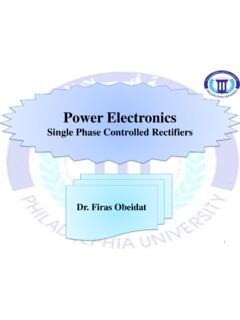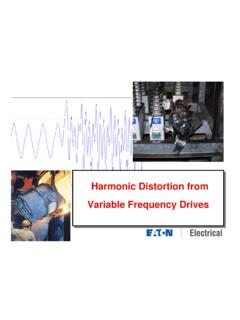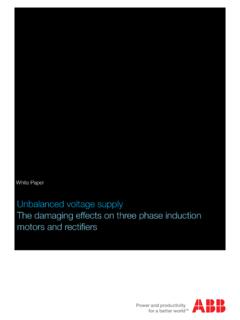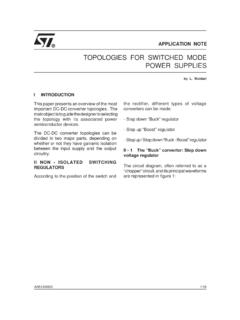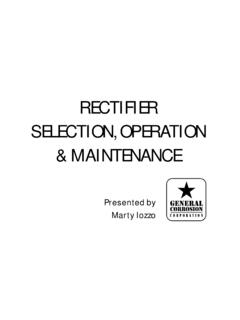Transcription of The third harmonic frequency - a guide to the problems and ...
1 THF 80 GB 99-09 The third harmonic frequency - a guide to the problems andhow to solve themThe third harmonic GuidebookABB ControlContents1268182632341. third harmonic frequencies - a growing Generation of the third third harmonics generate large neutral Conductor problems caused by the third 164. third harmonic Filters (THFs).. Eliminating third harmonic Decreasing the risk of Energy Decreasing the magnetic 245. Voltage Installation of the filter in different Network structures and methods of Generation of interference in the Fault current monitoring in the TN-S 317.
2 Determination of the A typical measurement 338. Choosing and installing third harmonic Filters for different Filters in a distribution Dimensioning filters for a transformer 37 ABB Control Oy27 All electrical equipment using alternating current is designed touse a voltage with a clean and regular sine wave. However, inpresent day networks, this type of curve is extremely rare. Harmonicfrequencies create distortions in the sine wave, causing interferenceto equipment connected to the harmonics are generated by non-linear loads which are connectedto the network. These loads create ripple voltages that generateharmonics at the same frequency .
3 The size of the harmonic currentdepends on the load and the impedance of the feeding network atthe frequency in question. For instance lighting, semiconductor andPC loads generate harmonic voltages and currents of different containing small transformers, UPS equipment andemergency power supplies, among other things, are vulnerable toharmonics, and there is a big risk of harmonic currents causinginterference to equipment connected to these third harmonic frequencies -a growing problemABB Control Oy3 Non-linear loads generate harmonics in networksThe most common harmonics which stress networks are the 150 Hz thirdharmonic.
4 250 Hz fifth harmonic and the 350 Hz seventh harmonicABB Control Oy~50 Hz150 Hz250 Hz350 Hz~VoltageCurrentA non-linear loadThe most common harmonics which stress networks are the 150Hz third harmonic , 250 Hz fifth harmonic and the 350 Hz seventhharmonic. Generally, single-phase loads generate the third harmonicand three-phase loads generate the other harmonics. The fifth andthe seventh harmonics can be filtered out by so called tunedcircuits .Until recently, there was no economic way to filter the thirdharmonic. Now ABB Control has developed a third HarmonicFilter (THF) which eliminates up to 95% of third harmonics ina this guidebook, we describe the effects of the third harmonicin networks.
5 The generation and detection of third harmonics andthe elimination of third harmonics by means of the third HarmonicFilter - THFStr mbergABB Control OyStr mbergTHFTHFStr mberg Test OOFFOKByPassTestReset5 The effects of harmonicsSequenceDirection of rotationEffects+forwardHeating -backwardsHeating and problems for motors 0insignificantHeating of neutral conductor accumulation in neutral conductorThe classification of Hz 150 250 350 450 550 650 +0-+ fifth and seventhharmonics can be filteredout by tuned circuits .Suck circuits, however, donot eliminate the Control OyLoad690V~ or 400V~12 or 24kV~ circuits6 The increasing use of non-linear equipment, such as dischargelamps and computers, causes problems for networks and otherequipment because of their generation of third harmonics.
6 A non-linear load generates a 150 Hz harmonic current in the third harmonic can generate a current in the neutral conductorwhich is even larger than the current in the phase generate considerable levels of third harmonic instance, a common office-PC generates a 4 A/kW, 150 Hzcurrent in a network. All discharge lamps, such as fluorescent lamps, mercury vapourlamps, high-pressure sodium lamps, multimetal discharge lamps,halogen lamps, PL-lamps etc. generate harmonics. A discharge lampwill generate a 1 A/kW, 150 Hz current in a level of harmonics caused by rectifiers is dependent on thenumber of pulses used by the rectifier .
7 12-pulse rectifiers generateless harmonics than 6-pulse rectifiers. Three-phase rectifiers do notgenerate any third Generation of the third harmonic Computers Office equipment Discharge lamps Welding equipment GeneratorsABB Control Oy Rectifiers UPS Induction furnaces Home electronics (TV, radio, microwave ovens etc.)Equipment that generates third harmonics includes:PC-loadTV + video + radio + CD + tape recorder7 ABB Control OyHarmonics and distortion of sine curves caused by different loads:UPSS00251A8In symmetrical loads, when all three phases are loaded equally,there is no current in the neutral conductor.
8 However, if there arethird harmonics in a network, currents also appear in the neutralconductor. The third harmonic is in the same stage in every phaseof a three-phase system, causing the current generated by harmonicsto accumulate in the neutral discharge lamp systems, the harmonic content in phaseconductors can rise by up to 30 % of the phase current values. Thus,the neutral conductor is loaded with 3 x 30 %, or 0,9 times thephase current. Examples exist of 150 Hz currents being measuredin neutral conductors in bank buildings. These were up to threetimes stronger than the load currents in the phase installations where the dimension of the neutral conductor isonly half that of the phase conductor, it is evident that the neutralconductor is overloaded.
9 This can create a fire risk because theneutral conductor is not protected by a third harmonics generate large neutral currentsABB Control Oy9 third harmonicsaccumulate in Control Oy 1,00 0,40 0,00-0,40-1, 1,00 0,40 0,00-0,40-1, 1,00 0,40 0,00-0,40-1, 1,00 0,00-1,00 1,00 0,00-1,00L1L2L3S00248A0,0030609012015018 02102402703003300,0030609012015018021024 02703003300,0030609012015018021024027030 03300,003060901201501802102402703003300, 00306090120150180210240270300330 The American CBEMA (Computer-Business Equipment ManufacturersAssociation) has recommended that, due to the risk of fire caused bythird harmonics, the cross-section of neutral conductors should be atleast 1,73 times the cross-section of the phase conductor.
10 Generally,the cross-section of the neutral conductor is 50 % of the cross-sectionof the phase regulations have come into force in Sweden and Finland, inaccordance with the international EMC-directive. In these regulations,the dimensioning of the neutral conductor must take account of theload in the neutral conductor caused by the third The cross-section of the neutral conductor must be the same asthe cross-section of the phase conductors:- in single-phase circuits regardless of the cross-section and- in polyphase circuits, when the cross-section of the phase conductorsis up to 16 mm2 copper or 25 mm2 In polyphase circuits, where the cross-section of the phaseconductors is larger than 16 mm2 copper or 25 mm2 aluminium, thecross-section of the neutral conductor may be smaller than the cross-section of the phase conductors.
